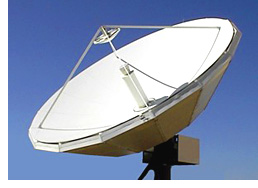 By Andrew Liszewski
By Andrew Liszewski
The ionosphere is a layer of the earth’s atmosphere sitting about 50 kilometres above our heads and is already used to bounce low frequency radio signals around the planet. Researchers at Samsung are taking that idea even further by developing a way to use the ionosphere as an actual broadcast antenna.
To achieve their goal Samsung plans to use a UHF radio signal of a few hundred megahertz coupled with a carrier signal of around 1 gigahertz. The two signals would be amplified and focused by a dish into a beam that hits the underside of the ionosphere. The plan is for the 1 GHz carrier signal to be absorbed by the atmosphere while the UHF signal is used to alter the temperature of electrons flowing through the ionosphere. This would create an alternating current in the ionosphere that could be modulated at a particular frequency. The spot where the beam hits the ionosphere would then effectively work as an antenna radiating the UHF signal back down to the planet.
Samsung hopes this will pan out as a cheap way to broadcast signals or communicate over long distances without the need for launching and maintaining expensive satellites.
[Atmospheric Broadcasting Patent Application] VIA [New Scientist Invention Blog]










